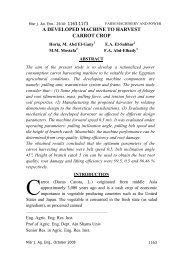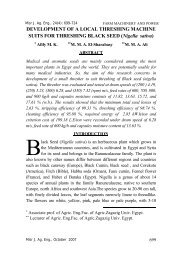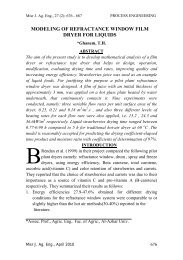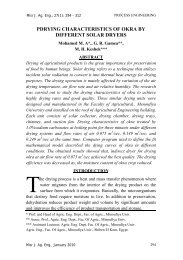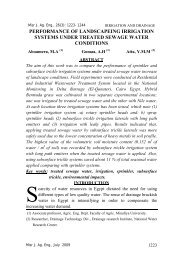Full Text - Misr Journal Of Agricultural Engineering (MJAE)
Full Text - Misr Journal Of Agricultural Engineering (MJAE)
Full Text - Misr Journal Of Agricultural Engineering (MJAE)
Create successful ePaper yourself
Turn your PDF publications into a flip-book with our unique Google optimized e-Paper software.
<strong>Misr</strong> J. Ag. Eng., 26(3): 1318- 1335IRRIGATION AND DRAINAGEPERFORMANCE ANALYSIS OF SELF –COMPENSATING GATED PIPE FOR IMPROVINGSURFACE IRRIGATION EFFICIENCYEL-Shafie, A. F .1 ; O.M. Beder 2 ; M. M. Hussein 3 ; A.M. El-Gindy 4ABSTRACTRationalizing irrigation water and maximizing water use efficiencybecame the priority of irrigation planners and users under Egyptianconditions. Therefore, the aim of this study was to evaluate adjusted ofself-compensating gated pipe for modified surface irrigation and toevaluate the pepper yield response and water use efficiency under threeirrigation system (drip irrigation ,traditional gated pipe and modifiedgated pipe) and three water treatments (100, 75 and 50% of ETC) in oldland conditions of Egypt. Hereby field experiments were carried out atthe Experimental Farm of Faculty of Agriculture, Ain Shams University,Kalubia Governorate, which represents alluvial soils, for two successivegrowing seasons 2006 and 2007. Results revealed that. In laboratoryexperiments of self-compensating gated pipe out let average dischargefrom 29 L/min were obtained at pressure range of (2 – 9 kPa) withcoefficients of variation less than 0.9%. Uniform discharge was obtainedat modified gated pipe under pressure range of 45-90 cm. Correspondingfield data were similar to laboratory data. Regular uniform water flowfrom gates and regular uniform pressure head from each outlet wasobtained along line at modified gated pipe under constant pressure.Regular advance times approximately was obtained in modified gatedpipe along furrows (0.6, 1.5, 2.6, 4, 5.4 and 6.7 min) at the first furrowand (0.7, 1.7, 3, 4.5, 6.2 and 7.7 min) in the end furrow at distance inmeter (4, 8, 12, 16, 20, 24 m) respectively the same trend of recession1-Researcher Assistant, Water Relations and Field Irrig. Dept., National Research Center2-Lec., Agric. Eng. Dept., Fac. of Agric., Ain Shams Unvi.3-Prof. Water Relations and Field Irrig. Dept., National Research Center.4-Prof. Agric. Eng. Dept., Fac. of Agric., Ain Shams Unvi.<strong>Misr</strong> J. Ag. Eng., July 2009 1318
time (min).Uniformity coefficient of distribution (CUD) along traditionaland modified gated pipe was 82.7% and 96.3%, respectively. The highesttotal fresh pepper fruit yields (14319.5 kg/fed) with 75% of ET C undermodified gated pipe, respectively. Water use efficiency treatment 50 % ofET C under drip irrigation was the superior in WUE (5.7 kg/m 3 ).INTRODUCTIONNile Valley and Delta soils are mainly irrigated based on surfaceirrigation system which is with quiet low efficiency that ranged ofabout 47 up to 50%. Due to limited water resources, arid climateand fast increasing of in population, more water is required foreliminating the demand available balance gape. Therefore, developingsurface irrigation by using gated-pipes technique provides an importanttool to improve its performance. Uniform water flow may be regulated byadjusting the size of the outlet opening manually with some difficulties,which may be reducing water application. Osman, 2000 mentioned thatgood design of gated pipes with precision land -leveling may improve thewater distribution uniformity and save irrigation water by about 12 and 29% in cotton and wheat, resp. El-Sayed, 1998 foundthat the required head to efficiency. Short flexible sieves may be attachedto the outlets to dissipate energy and minimize erosion at furrow inlets.Operate the GP is 50 cm or less under alluvial soil conditions. El-Gindyet al., 2000 found that by using gated pipe, irrigation significantlyaffected fruit shape homogeneity and specific weights of fruit andpericarp. Osman, 2003 conducted two field experiments for two growingseasons (2000 and 2002) to investigate the response of field crops and oldMango farm to the modified surface irrigation system with gated pipescomparing with traditional, to determine the actual water requirementsand economical efficiency, for some field crops such as cotton, wheat,corn and rice crops. Results indicated that by using gated pipes, thehighest cotton, wheat, corn and rice yield, were obtained (61.1, 65.2, 116and 53.6 %) when compared to the traditional irrigation system.Meanwhile, water saving was (29.64, 29.9, 14.5 and 19.7 %) in cotton,wheat, corn and rice compared with traditional (flooding) system. Wateruse efficiencies for an improved surface irrigated cotton, wheat; corn andrice were higher than traditional system, by (129, 137, 154.4 and 79.4 %),<strong>Misr</strong> J. Ag. Eng., July 2009 1319
espectively. The same results showed that using gated pipes obtained thehighest mango yield by 37.2% technique. Also, water was saved by19.8% in mango compared with traditional system. Water utilizationefficiency by using improved surface irrigated mango with gated pipes,increased by 70.7% compared with traditional system. El- Awady et al.,2004 stated that the hydraulics characteristics of rectangular – gated pipeswere studied by observing the distribution uniformity of flow, pressurealong pipe and the discharge coefficient for the gate. Results included: (1)laboratory work to calibrate sliding gates under different pressures, outletareas and discharge coefficients, (2) theoretical determination of suitableoutlet area to give high distribution uniformity by a new mathematicalapproach, and (3) field work to examine the results under calculatedoutlet areas along 6" (150 mm) gated pipe. Results also showed greatagreement the theoretical gated pipe flow rate, based on newly derivedequation and the corresponding fieldwork. El- Awady et al., 2005 statedthat the hydraulic and engineering factors affecting the design of a Self-Compensating Gated Outlet (SCGO) found that the Average dischargesfrom 10.75 to 21.7 L/min were obtained at pressure range of (2 – 9 kPa)coefficients of variation of less than 0.9 %, and head exponent close tozero. Mathematical model & dimensional analysis approach could beused to predict the designed gate outlet discharge with correlation rangeof 96- 99% between measured and calculated data.The main objectives of this study:To evaluate adjusted and self-compensating gated pipe for modifiedsurface irrigation and evaluated the pepper yield response and improvewater use efficiency under three water treatments (100, 75 and 50% ofET C ) in old land of Egypt.MATERIALS AND METHODSExperimental site:Field experiments were carried out in the Experimental Farm of Facultyof Agriculture, Ain Shams University, El-Kanater city, KalubiaGovernorate, to study the performance analysis of self-compensatinggated pipe, traditional gated pipe and effect of irrigation system (drip<strong>Misr</strong> J. Ag. Eng., July 2009 1320
irrigation ,traditional gated pipe and modified gated pipe) and waterrequirements on yield and water use efficiency of pepper crop.Some physical properties of the soil:Soil particle size distribution was carried out using Pipette method after(Gee and Bauder, 1986). Soil bulk density (B.D) was measured after(Black and Hartage, 1986). Soil moisture content at field capacity (F.C)and permanent wilting point (P.W.P) were measured according to(Walter and Gardener, 1986).Table 1. Some soil physical properties of the soil:Particle Size Distribution, % FC PWP AWSoil depth,BD <strong>Text</strong>urecmCoarse FineSilt Clay θ (g /cm 3 ) classSand Sandw %0-15 0.81 27.8 41.44 29.95 35.45 19.2 16.25 1.25 C.L15-30 0.7 27.5 41 30.6 35.2 19.44 15.76 1.26 C.L30-45 0.61 27.8 38.45 33.14 34.7 19.8 14.9 1.28 C.LFC: Field capacity; PWP: permanent Welting point (Fc and PWP) were determined as percentage in weight;B.D: Bulk density; AW: Available water; CL: Clay loamSome chemical properties of soil:Some chemical properties of the soil were measured such as:Soil pH and EC were measured in 1:2.5 soils: water suspension and insoil past extract, respectively. Soluble cations and anions were determinedby titration methods and flame photometer according to Jackson (1967).Some chemical properties of the soil are presented in Table (2).Table 2. Some chemical analysis of the soil:Sampledepth, cmpH1:2.5ECedS/m1:5Soluble Cations, meq/LCa +2 Mg +2 Na + K + CO 3--Soluble Anions, meq/LHCO 3-0-15 7.9 0.26 0.41 0.47 0.43 0.19 - 0.64 0.36 0.5015-30 7.8 0.25 0.46 0.35 0.50 0.17 - 0.76 0.15 0.5730-45 7.6 0.26 0.55 0.54 0.61 0.2 - 0.78 0.34 0.78SO 4--Some chemical properties of irrigation water:Chemical analyses of irrigation water were carried out by using thestandard methods and they are presented in Table (3).Table 3. Some chemical analysis of irrigation water.ECSoluble Cations, meq/LSoluble Anions, meq/LpHSARdS/m Ca +2 Mg +2 Na + K + ---HCO 3 SO 4 Cl -7.37 0.85 1.72 0.85 4.78 0.85 2.18 0.14 5.88 4.22Cl -<strong>Misr</strong> J. Ag. Eng., July 2009 1321
Irrigation systems:Control head is located at the source of the water supply. It consists ofcentrifugal pump (80 m 3 /h discharge,30 HP and 50 m lift), control value,pressure gauges, P.V.C pipes main line were used to convey the waterfrom the water source to the main control points in the field. Threeirrigation systems were selected to irrigate pepper plants. The first issurface built in drip lines system (GR, 4 L/h) with 50cm emitters spacing(SDI) 16mm laterals were used at 60 cm spacing. The second system ismodified gated pipe with self- compensating gate outlet (SCGO) Gatedpipe body was made of a P.V.C of 63 mm diameter gates diameters is 63mm distance between gates along line was 60 cm The third system istraditional Gated pipe body was made of a P.V.C of 63 mm diametergates distance between gates along line was 60 cm.Components of the designed (SCGO).The developed self-compensating gate outlet (SCGO) consists of fourparts, as shown in Figs. 1 and 2.Gated outlet body: The gate outlet body was made of a P.V.C pipe of 63mm out side diameter. The total length of the gate cutlet body is 35cm.The grooved disk rests at 10 cm from the body end. 2) Grooved disk: AP.V.C disk of 58.64 mm diameter of variable thickness was insertedinside the gate outlet body. Four similar radial grooves were formed onthe surface of the disk to perform the compensating action together with arubber membrane. 3) Rubber membrane: of 52.25 mm diameter, 3.38mmthickness and stiffness of 26.27 N/cm. 4) Pin: A P.V.C pin of 4 mmdiameter was made to fasten rubber membrane with grooved disk.Laboratory experimentsLaboratory apparatus was used to measure pressure range from 20-90 cmwith an accuracy of 10cm consisting of water manometer and waterreservoir with an over flow pipe to establish constant head devise for(SCGO) calibration as shown in fig.3.<strong>Misr</strong> J. Ag. Eng., July 2009 1322
RubberGrooveddiskGrooveddiskP.V.CsupportP.V.CGatedFig.1 Grooved disk detailFig.2 Gate outlet assembly sectionTank ofwaterPizometric tubeControl Valve 2 ''Tested gateFig.3 schematic laboratory apparatus constructed for gated orificetest.Irrigation water requirement calculation:Irrigation water requirements for pepper were calculated according to thelocal weather station data at Shalakan affiliated to the Central Laboratoryfor <strong>Agricultural</strong> Climate (C. L. A. C), Ministry of Agriculture and LandReclamation. Irrigation water requirement for pepper crop was calculatedfrom the following equation (Vermeiren and Jobling, 1980):IR = (ET 0 x Kc x Kr / Ei) + LRWhere: IR = Irrigation water requirements.ET 0 = Reference evapotranspiration mm/dayKc = Crop coefficient fore pepper crop.Kr = Reduction factor due to ground cover.<strong>Misr</strong> J. Ag. Eng., July 2009 1323
Ei = Irrigation system efficiency.LR = Leaching requirements.Water treatments:Three water application rates were applied for irrigating pepper crop: i.e.50 %, 75 % and 100 % of water requirements of pepper crop ET CTable (4): Average actual application water treatments of towseasons:Irrigation system WatertreatmentsDrip irrigation system 100% 309275% 231950% 1546Modified gated pipe 100% 406675% 305050% 2033Traditional gated pipe 100% 460875% 345650% 2304Traditionalgated pipeModifiedgated pipeActual application m 3 /fedSurface Drip24 m75 % ET C50% ET C50 % ET C100 % ET C100% ET CØ 75mm75 % ET C100% ET C50 % ET C75 % ET C11 mØ 110mmPumpFig. (4) The layout of the experimental design of irrigation systems<strong>Misr</strong> J. Ag. Eng., July 2009 1324
Measurements and Calculations:Laboratory experimentsGate dischargeThe discharge of gate was determined at different pressure-heads.The following formulas were used to calculate average discharge anddischarge range.q min. + q max.q mean. = * 1002q min. or max - q mean.q rang +% = * 100q meanq av = ∑q / nWhere: q: discharge, L/min, n: number of measured points, q min. : meandischarge, L/min, q min. : minimum discharge, L/min, q max : maximumdischarge, L/min, ∑q: summation of discharge, L/min, q av. : averagedischarge, L/ min, and q rang + : discharge variation, %.Coefficient of variationHydraulic design of drip irrigation lateral-line is usually based on a designcriterion (El- Awady et al., 1976 and Wu et al., 1979) using an emitterflow variation.MCV = (s/q)"s" is the standard deviation of emitter flow and "q" is the mean emitterflow. The manufacture coefficient of variation (MCV) ranges, in general,from 0.5 to 0.2 for different emitters and lateral-lines (Solomon, 1979and Bralts, 1978). The AENRI-LOFTI-MSAE Standard(dr\em\test\2002) interpreted MCV as follows " 0.2 → UNSATISFACTORY.Manufacturing coefficient was calculated for the designed gate outlet todetermine its effect on the total variation caused along lateral-line.<strong>Misr</strong> J. Ag. Eng., July 2009 1325
Field experiments1- Hydraulic performance analysis:a- Measuring discharge along line of traditional and modified ofgated pipe under different operating pressure range from (45-90) cm using piezometer tube.b- Measuring discharge and pressure head of gates outlet alongpipe line of traditional and modified gated pipe under constantpressure.c- The advance time (min), and recession time (min) and of waterwere recorded at seven points at equal distances along eachfurrow of traditional and modified gated pipe.d-Uniformity coefficient was calculated by using the Christiansenuniformity coefficient "CU" (Perold, 1977 and AENRI-LOFTI-MSAE, 2002)CU= (1- | δ | ) *100Where: CU: uniformity coefficient| δ | :Absolute mean deviation of discharge on along line of pipe2- Economic yield kg/fed3-Water use efficiency:Water use efficiency is an indicator of efficiency of irrigation unit for increasing crop yield. Water use efficiency of yield was calculated fromWUE kg/m 3 =Marketable pepper yield (kg)Irrigation water quality (m 3 )RESULTS AND DISCCUSSIONLaboratory experimentsHydraulic characteristics of designed gate:Fig. 5 shows that self compensating gate outlet discharge slightlyincreased by increasing pressure in the range (2-9kPa) with gate outletdischarge of 29 lit/min for design geometries that reflect the effect ofcompensation action caused by grooved disk and rubber diaphragm ondischarge regulation.<strong>Misr</strong> J. Ag. Eng., July 2009 1326
q lit/min353025201510500 10 15 20 25 30 35 40 45 50 55 60 65 70 75 80 85 90h cmFig. 5. Effect of pressure on measured discharge for selfcompensating gate outlet.Hydraulic characteristic details are summarized in Table 5, showing themanufacture coefficient of variation 0.09 % when gate outlet discharges29 lit/min. The manufacture variation may be due to the hand making ofdisk groove. Variations are within "GOOD" category according toAENRI – LOFTI – MSAE standard (2002). Head exponent is 0.1841showing an acceptable compensating degree for tested gate outlets.Table (5): The hydraulic characteristic details for developed ofmodified gated pipeGate av. Discharge, LPMq., q q q +q *C.V **δlit/min. Min. Max. mean range%29 13 29 21 38.1 0.09 1.923* Coefficient of variation, ** Standard deviationField experiments1- Hydraulic performance analysis:Measuring discharge along line under different operating pressureFig. 6 and 7 show the effect of different operating pressure head ondischarge from each outlet along line of traditional and modified gatedpipe (LPM) (Average discharges modified gated pipe of 15 gates a longline between 1.8 – 2 L / m) at pressure head range of 45-90 cm uniformdischarge was obtained at modified gated pipe under pressure range of45-90 cm.Measuring discharge and pressure head of gates outlet along pipe lineunder constant pressureFig 8 and 9 show that uniform water flow and uniform pressure head fromeach outlet is unregulated along line of traditional gated pipe but uniform<strong>Misr</strong> J. Ag. Eng., July 2009 1327
water flow and uniform pressure head from each outlet is regulated a longline of modified gated pipe45 cm 50 cm 55 cm 60 cm 65 cm70 cm 75 cm 80 cm 85 cm 90 cm.Discharge of gated pipe ( l /min )2.82.72.62.52.42.32.22.121.91.81.71.61.51.41.31.21.111 2 3 4 5 6 7 8 9 10 11 12 13 14 15gate numberFig.6 Discharge of traditional gated pipe (LPM) under operatingpressure head rang from (45-90) cm.Discharge of gated pipe ( l /min )2.052.032.011.991.971.951.931.911.901.881.861.841.821.8045 cm 50 cm 55 cm 60 cm 65 cm70 cm 75 cm 80 cm 85 cm 90 cm1 2 3 4 5 6 7 8 9 10 11 12 13 14 15gate numberFig. 7 Discharge of modified gated pipe (LPM) under operatingpressure head rang from (45-90 cm).Traditional GPModified GP. Discharge of gatesoutlet ( LPM )30201001 2 3 4 5 6 7 8 9 10 11 12 13 14 15No. of gatesFig.8. Discharge of gates outlet (LPM) a long pipe line of traditionaland modified gated pipe.<strong>Misr</strong> J. Ag. Eng., July 2009 1328
Traditional GPModified GPPressur head of gatesoutlet (cm)8060402001 2 3 4 5 6 7 8 9 10 11 12 13 14 15No. of gatesFig. 9. Pressure head (cm) of gates outlet a long pipe line oftraditional and modified gated pipe.Data presented in Tables 6 and 7 show that advance time (min) of wateralong each furrow of traditional and modified gated pipe along of pipe. Intraditional GP advance time increased from (0.5, 1.1, 2.1, 3.2, 4.3 and 5.4min) at the first furrow to (1.4, 3.2, 4.8, 8.7, 11.8 and 14.6 min) in the endfurrow at distance in meter (4, 8, 12, 16, 20, 24 m), respectively. On theother hand, there are regular advance times approximately in modified GPalong furrows (0.6, 1.5, 2.6, 4, 5.4 and 6.7 min) at the first furrow and(0.7, 1.7, 3, 4.5, 6.2 and 7.7 min) in the end furrow at distance in meter (4,8, 12, 16, 20, 24 m), respectively. This may be due to uniform ofdischarge and pressure head along pipe line, are shown Figures 8 and 9.The same trend of recession time (min) in traditional and modified gatedpipe at the first furrow and the end furrow at distance in meter (4, 8, 12,16, 20, 24 m), are shown Tables 8 and 9.Table (6): Time of advance (min) of water along each furrows oftraditional gated pipe along of pipe.Distancein meterTime of advance, minNo. of furrow1 2 3 4 5 6 7 8 9 10 11 12 13 14 154 0.5 0.6 0.6 0.7 0.7 0.7 0.8 0.8 0.8 0.8 0.8 0.9 1.0 1.1 1.48 1.1 1.3 1.4 1.6 1.7 1.7 1.9 1.9 1.9 1.9 1.9 2.0 2.2 2.5 3.212 2.1 2.3 2.5 2.8 3.1 3.1 3.3 3.3 3.3 3.3 3.3 3.5 4.0 4.5 5.816 3.2 3.4 3.8 4.2 4.7 4.7 5.0 5.0 5.0 5.0 5.0 5.3 6.0 6.8 8.720 4.3 4.7 5.2 5.7 6.5 6.5 6.9 6.9 6.9 6.9 6.9 7.2 8.1 9.3 11.824 5.4 5.7 6.4 7.0 8.0 8.0 8.5 8.5 8.5 8.5 8.5 8.9 10.1 11.5 14.6<strong>Misr</strong> J. Ag. Eng., July 2009 1329
Table (7): Time of advance (min) of water along each furrows ofmodified gated pipe along of pipe.DistanceinmeterTime of advance, minNo. of furrow1 2 3 4 5 6 7 8 9 10 11 12 13 14 154 0.6 0.6 0.7 0.7 0.7 0.7 0.7 0.7 0.7 0.7 0.7 0.7 0.7 0.7 0.78 1.5 1.5 1.6 1.6 1.6 1.6 1.6 1.6 1.6 1.6 1.6 1.6 1.7 1.7 1.712 2.6 2.6 2.8 2.8 2.8 2.8 2.8 2.9 2.9 2.9 2.9 2.9 3.0 3.0 3.016 4.0 4.0 4.2 4.2 4.2 4.2 4.2 4.3 4.3 4.3 4.3 4.3 4.5 4.5 4.520 5.4 5.4 5.7 5.7 5.7 5.7 5.7 5.9 5.9 5.9 5.9 5.9 6.2 6.2 6.224 6.7 6.7 7.0 7.0 7.0 7.0 7.0 7.3 7.3 7.3 7.3 7.3 7.7 7.7 7.7Table (8): Time of recession (min) of water along each furrows oftraditional gated pipe along of pipe.DistanceinmeterTime of recession, minNo. of furrow1 2 3 4 5 6 7 8 9 10 11 12 13 14 154 125 127 127 129 129 129 130 130 130 130 130 130 131 131 1318 131 132 132 133 135 135 132 132 132 132 132 132 133 133 13312 133 134 133 134 135 135 134 134 134 134 134 134 135 134 13416 134 135 135 135 135 135 135 135 135 135 135 135 136 136 13720 135 135 135 135 135 135 135 135 135 135 135 135 136 137 13824 135 135 135 135 135 135 135 135 135 135 137 137 138 140 140Table (9): Time of recession (min) of water along each furrows ofmodified gated pipe along of pipe.DistanceinmeterTime of recession, minNo. of furrow1 2 3 4 5 6 7 8 9 10 11 12 13 14 154 123 123 126 126 126 126 126 129 129 129 129 129 129 129 1298 130 130 133 133 133 133 133 135 135 135 135 135 135 135 13512 130 130 133 133 133 133 133 135 135 135 135 135 135 135 13516 135 135 134 134 134 134 134 135 135 135 135 135 135 135 13520 135 135 135 135 135 135 135 135 135 135 135 135 135 135 13524 135 135 135 135 135 135 135 135 135 135 135 135 135 135 135<strong>Misr</strong> J. Ag. Eng., July 2009 1330
Uniformity coefficientUniformity coefficient of distribution (CUD) along line of traditional andmodified gated pipe it was found (82.7 and 96.3 %), respectively revertthat increase because modified gated pipe contain self compensatingpressure perform increase of uniform discharge of gates outlet alongpipe line. The uniformity considered "GOOD" values for modernirrigation systems according to AENRI – LOFTI – MSAE standard(2002).Economic yield kg/fedConcerning combined analysis Average the two growing season of freshyield/fed data illustrated in Fig. (10) showed that the effect of irrigationsystems and water regimes on fresh yield/fed of pepper. Generally thehighest value (14319.5 kg/fed) under modified GP irrigation system byirrigated 75% ET C . The modified GP gave the superior in fresh pepperyield (12303.8, 14319.5 and 10833.2 kg/fed) by irrigated 100%, 75% and50% ET C treatments, respectively. Followed by drip irrigation system(12299.1, 11057.5 and 8763 kg/fed) by irrigated 100%, 75% and 50%ET C treatments respectively. While traditional GP irrigation system camelater (9433.7, 8762.9 and 8199.4 kg/fed) by irrigated 100%, 75% and50% ET C treatments, respectively. This might concluded that irrigated by75% ET C under modified GP irrigation system induced the same effect onyield of pepper crop. Klar and Jadoski (2004) found that the droughtstress caused significant on production and quality of sweet pepper.Sezen, et al. (2006) reported that poly normal relations were foundbetween pepper yield and total water use for each irrigation treatments inboth seasons.Average of the two growing season.Yield kg/fed180001500012000900060003000012299.1 11057.58763.314319.512303.810833.29433.7 8762.9 8199.4100% 75% 50% 100% 75% 50% 100% 75% 50%Drip Modified GP Traditional GPFig. 10 Effect of irrigation systems and water treatments on Yield<strong>Misr</strong> J. Ag. Eng., July 2009 1331
Water use efficiency kg/m3Concerning combined analysis. Effect of irrigation system and waterregimes are presented in Fig. (11). Data in dictated that WUE under thedifferent system and water. Generally the highest value (5.7 kg/m3) underdrip irrigation system by irrigated 50% ETC. The drip irrigation gave thesuperior in WUE (4, 4.8 and 5.7 kg/m3) by irrigated 100%, 75% and 50%ETC treatments, respectively. Followed by modified GP irrigation system(3, 4.7 and 5.3 kg/m3) by irrigated 100%, 75% and 50% ETC treatments,respectively. While traditional GP irrigation system came later (2, 2.5 and3.6 kg/m3) by irrigated 100%, 75% and 50% ETC treatments,respectively. This might concluded that irrigated by 50% ETC under dripirrigation system induced the same effect on WUE of pepper crop. Dataalso noticed that the effect induced by water stress under drip irrigationwas less than those caused under modified GP irrigation system andtraditional GP irrigation system under latter more less than modified GPirrigation system. Abd-rabbo, et al. (2006) of treatment under dripirrigation gaves WUE (2.40 kg/m3). El-Dakrorry (2008) showed that inthe 1st season, surface drip irrigation exhibited the high values of WUEbut in the 2nd season, the two drip irrigation was equal. However, thelowest significant vales were by furrow irrigation, whereas gated piperanked in between.WUE kg/m36.05.04.03.02.01.00.0Average of the two growing season4.0 4.8 5.7 4.7 5.33.03.62.02.5100%75%50%100%75%50%100%75%50%Drip Modified GP Traditional GPFig. 11 Effect of irrigation systems and water treatments on WaterUse efficiency.<strong>Misr</strong> J. Ag. Eng., July 2009 1332
REFERENCESAbd-rabbo, M. A; Hassanain, M. K. and Medany, W. A:(2006).Improve in WUE for drip irrigation of maize in Egypt. J. Appl.Sci, 21(11B) : 478 – 485.AENRI-LOFTI-MASE (2002). Standard for irrigation dripper testing,Code No. ir/dr/em/test/2002, The Ag. Eng. Res. Inst. Irrig. Proj.– <strong>Misr</strong> Soc. Ag. Eng. Standard: 5p.Black, G. R. and K. Hartage (1986). Bulk density Methods of SoilAnalysis. Part1 A gron. 2 nd ed. 363-376. ASA and SSSA,Madison, WI (c. ed. Klute, R.).Bralts, V. (1978). The effect of emitter flow variation on the design ofsingle and dual chamber drip irrigation system. M. Sc. Th.,Hawaii U.: 30-45.El- Awady, M.N.; G.W. Amerhom, and M. S. Zaki (1976). Trickleirrigation trail on pea in conditions typical of Qalubia, Egypt. J.Hort. Sc., 3(1): 99-110.El- Awady, M. N.; M. T. El- Tanawy: S. S. Hassan and A. O. M. El-Ashhhab (2004). Water- flow uniformity through irrigationgated – pipes. http//www.yahoo.com.El- Awady, M. N.; A. M. El- Lithy and M. A. Osama (2005). Designand testing of self- compensating outlet for irrigation gated pipe.MISR J. Ag. Eng., 22(3) 775-791.El-Dakroury, M.A. (2008). Influence of different irrigation systems andtreatments on productivity and fruit quality of some beanvarieties. M.Sc. Thesis, Faculty of Agriculture Ain ShamsUniversity. Cairo, Egypt.El-Gindy, A.M.; E.A. El-Sahar and A.A. Abdel-Aziz (2000). Physicaland mechanical properties of mango fruits under differentirrigation systems. Annals-of-<strong>Agricultural</strong>-Science- Cairo 1: 71-91.El-Sayed,-G-H (1998). Hydraulic studies for gated pipes distributionsystem. Egyptian-<strong>Journal</strong>-of-<strong>Agricultural</strong>-Research. 1998;76(1): 387-403<strong>Misr</strong> J. Ag. Eng., July 2009 1333
Gee, G. W. and J. W. Bauder (1986). Particle size analyses. Methods ofSoil Analysis. Part 1 Agron. 2 nd ed. 383-412 ASA and SSSA,Madison, WI (c. ed. Klte, R.)Gencoglan, C; I.E. Akinci; S.Akinci; S.Gencoglan and K.Ucan (2005).Effect of different irrigation methods on yield of red hot pepperand plant mortality caused by Phytophthora capsiciLeon.<strong>Journal</strong>-of-Environmental-Biology; 26(4): 741-746Jackson, M. L. (1967). Soil chemical Analysis, Prentice Hall,Inc.,Englewood Cliffs, USA, 54-56.Klute, A. and C. Dirksen (1986). Hydraulic conductivity and diffusivity.Laboratory methods. P687-734 Methods of soil analysis. Part 1.Agronomy 2 nd edition. ASA and SSSA, Madison, WI. In A.Klute. led)Osman, H.E (2000). Gated pipes techniques for improved surfaceirrigation. Annals of <strong>Agricultural</strong> Science Cairo 1: 145-155.Osman, H.,(2003). Improved-irrigation – technologies - and- methods:Research, development and testing Proceedings ICID-International-workshop,-Montpellier,France,-14-19-September;1-17Perold, P. K. (1977). Design of irrigation pipe laterals with multipleoutlets, ASCE, 103 (Ir2): 179 – 195.Sezen, S.M; A.Xazar; and S.Eker, (2006). Effect of drip irrigationregimes on yield and quality of field grown bell pepper.Agric.Water Manag, 81:115-131.Solomon, K. (1979). Manufacturing variation of trickle emitters, Trans.of the ASAE. 22 (5): 1034 – 1038.Vermeiren, I. and G. A. Jobling (1980). Localized irrigation: designinstallation, operation, and evaluation. Irrigation and Drainagepaper No. 36. FAO Rome. 203 pages.Walter, H; and Gardener. (1986). Water content. Methods of SoilAnalysis. Part 1 Agron. 2 nd ed. 493-544 ASA and SSSA,Madison, WI (C. F. Klute, R).Wu, I. P., T. A.Howell, and E. A. Hilar (1979). Hydraulic design of dripirrigation systems, Tech. Bull. No. 105, Westren Reg. Res. Proj.W – 128 Report, Hawaii Ag. Exp. St., Hawaii U.: 80 pp.<strong>Misr</strong> J. Ag. Eng., July 2009 1334
الملخص العربيتحليل أداء بوابات ذاتية تنظيم الضغط لتحسين كفاءة الري السطحي٤٣٢١أحمد فارس الشافعي - أسامة محمد أحمد - محمد مرسي حسين -عبد الغنى محمد الجندىأجريت الدراسة بمحطة التجارب والبحوث الزراعية التابعة لكلية الزراعة- جامعة عين شمس-محافظة القليوبية في موسمي ٢٠٠٦ لدراسة أداء بوابات ذاتية تنظيم الضغط لتحسينكفاءة استخدام مياه الري وتقدير االنتاجية وكفاءة استعمال الماء لمحصول الفلفل تحت نظام الريبالتنقيط والري السطحي بألنابيب المبوبة التقليدي والمعدل باستخدام بوابة ذاتية التنظيم للضغطتحت معامالت مياه ١٠٠%، ٧٥% من االستھالك المائي لنبات الفلفل في االراضيالقديمة.وتتلخص النتائج فيما يلي:في تجربة المعمل تم الحصول علٮمتوسط تصرف ٢٩ لتر/ د في مدى ضغط ٠.٠٢وكان معامل االختالف النتظامية التصرف ٠.٩% . تمجويالحصول على انتظامية في التصرف من البوابات على طول خط الري لنظام االنابيب المبوبةالمعدل في مدى ضاغط ٤٥-٩٠ سم بالمقارنة بنظام الري التقليدي وھو مماثل لنتائج تجربةالمعمل. تم الحصول على انتظامية للتصرف والضاغط سم من البوابات على طول خط الريلنظام االنابيب المبوبة المعدل تحت ضغط ثابت.تم الحصول على انتظامية في زمن تقدم المياه٦.٧دقيقة وفيلنظام الري باالنابيب المعدل في اول الخطوطدقيقة على مسافات مختلفة على طول الخطالخط االخيرمتر ( على التوالي وبنفس المعدل تم الحصول على انتظامية فيزمن االنحسار. تم حساب معامل انتظامية التصرف لنظامي االنابيب المبوبة التقليدي والمعدلو٩٦.٣% على التوالي. سجل اعلى انتاجية لمحصول الفلفل (١٤٣١٩.٥كجمفدان) تحت نظام الري باالنابيب المبوبة المعدل و تحت معاملة مياة ٧٥% من االستھالكالمائي. كان افضل كفاءة استخدام للمياه تحت نظام الري بالتنقيط تحت معاملة مياة ٥٠% مناالستھالك المائي لنبات الفلفل (٥.٧كجم م٠.٠٩/(-٢٠٠٧ ،%٥٠ ،) ضاغط ٩٠- ٢٠ سم (،٥.٤ ،٤ ،٢.٦ ،١.٥ ،٠.٦)( ٧.٧ ،٦.٢ ،٤.٥ ،٣ ،١.٧ ،٠.٧)٢٤ ،٢٠ ،١٦ ،١٢ ،٨ ،٤)(٣/وكان ٨٢.٧%١-مساعد باحث، قسم العالقات المائية والري الحقلي، المركز القومي للبحوث.٢-مدرس الھندسة الزراعية، قسم الھندسة الزراعية، كلية الزراعة جامعة عين شمس.٣-استاذ العالقات المائية والري الحقلي، المركز القومي للبحوث.٤-استاذ الھندسة الزراعية، قسم الھندسة الزراعية، كلية الزراعة جامعة عين شمس.<strong>Misr</strong> J. Ag. Eng., July 2009 1335



